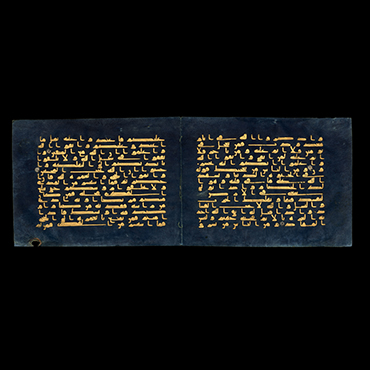Blue and gold magnificence
The Blue Qur’an is the best-known and most widely discussed copy of the holy text produced in the medieval Islamic world. The complete manuscript would have comprised around 600 folios, and considering the extreme care with which the luxurious materials were used, it must have been one of the finest and most valuable of its type produced during this period. Although the patron is unknown, they must have been of high rank. The color scheme highlights and glorifies the Word of Allah, with horizontally elongated text luminous in gold against the intense, deep blue background. Its elegant calligraphy and striking palette have made it an icon of Islamic art, with the majority of surviving folios housed in Tunisian public collections, while the rest are dispersed around the globe. This bifolium—or double page—is exceptional for its preservation.
In spite of this manuscript’s fame, very little is certain about its origins. The most recent research suggests it may have been written in North Africa or Spain around the mid-4th century AH/10th century CE. The practice of writing in gold is evident as early as the reign of the Umayyad caliph ʿUmar bin Abdulaziz (r. AH 98–101/717–20 CE), but the use of a blue-dyed surface dates back even further. The creative reuse of these colors in an Islamic context demonstrates the patron’s interest in employing pre-existing connotations of piety and power in a new setting, combining the medium and the message to potent effect.
Blue and gold magnificence
Holy Qur’an bifolio
From the Blue Qur’an
Spain or North Africa
c. AH 340–65/950–75 CE

